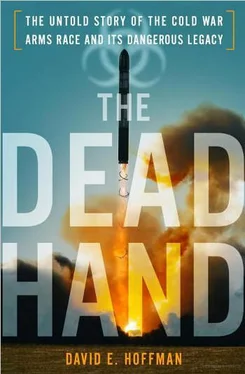The Soviet weapons designers wanted to match what Reagan was doing, a symmetrical response. By contrast, Velikhov argued for an “asymmetrical response,” one that would answer Reagan but not be the same. To stop ballistic missiles in flight, an American defense system would have to target and destroy a thousand speeding points in space almost perfectly and simultaneously. To counter it, one idea for “asymmetrical response” was to unleash so many speeding points—warheads, either real or fake—that the American defense system would be overwhelmed. Some of the Soviet missiles would penetrate and get through to their targets.
There were different ideas among Soviet experts about the hardware for “asymmetrical response.” According to Katayev’s records, Soviet engineers came up with technological tricks to fool the anti-missile system. For example, they could launch decoys or chaff, to imitate the warheads and deceive the defenses. They could spin and maneuver warheads to avoid detection, or blind the American satellites and command centers, knocking out the eyes of the defensive system.
Another method was more ominous: build more missiles and an avalanche of additional nuclear warheads. The Soviet Union was good at missiles, and it would be easier and cheaper to double or triple the missile warheads than to build an entirely new defense against them. This approach was hypothetical, but not entirely. Katayev recalled that the latest version of the SS-18 intercontinental ballistic missile carried ten warheads each. This was the biggest, most feared, multiple-warhead weapon in the Soviet arsenal. But if the missile’s range was shortened somewhat, and the warheads made smaller, he wrote, the SS-18 could actually be modified to carry “up to 40 nuclear warheads. And this one missile alone!” In a separate, more precise chart in his files, Katayev noted the modified SS-18 could carry thirty-eight warheads. At the time, the Soviet Union deployed 308 of these missiles. If they were modified, the fleet would go from 2,464 warheads to a total of 12,084. It would be much more difficult for American defenses to stop. This was only a concept that had been discussed in earlier years by missile designers, but it illustrated what could become a potent Soviet response to Reagan’s Star Wars. 48
Gorbachev would most certainly not favor this version of “asymmetrical response.” He wanted to eliminate weapons, not propagate them. In his memoir, he avoided talking about the details of this option. When the author questioned Gorbachev in an interview in 2006, he was still uneasy about discussing it. “We did have a project,” he said. “There was one. It existed. But it is closed down. And destroyed. It’s only tens of billions” of rubles. “But it’s a horrible project, it’s a horrible response.” He added, “What is one missile, SS-18? It’s a hundred Chernobyls. In one missile.” 49
More weapons were not the only answer. There was a third approach to “asymmetrical response.” Words were Gorbachev’s stock-in-trade, and his best weapon. He was a robust if long-winded orator. Could he simply say “no” to the Reagan dream, persuade Reagan of his folly and talk it into oblivion? Perhaps he could strike a deal to cancel a giant weapons machine that the United States did not yet possess, that the Soviet Union would have great trouble matching, and exchange it all for something they both wanted: deep reductions in existing nuclear weapons.
Gorbachev realized this was his best answer. If he could talk Reagan out of his dream of missile defense, it would prevent stiff competition on a field—high technology—where the Soviet Union lagged years behind. There was an important domestic component too. The military-industrial complex constantly pressed for more resources, saying the United States was a threat. If Gorbachev could persuade Reagan not to build “Star Wars,” he would find it easier to resist the generals and the missile designers at home. By slowing the arms race, Gorbachev might find time and resources to begin modernizing the country.
Yet in the summer of 1985, the military and defense industries were powerful forces. Velikhov saw Gorbachev was buffeted by crosscurrents. He was a man of the party who depended on the Central Committee bureaucracy; he had no choice but to listen to the generals, the ministers and the KGB; and the military establishment distrusted Velikhov, Yakovlev and other progressive thinkers around the general secretary. Gorbachev was personally wary of the military and defense industry, and surrounded himself with advisers who shared his caution, but he did not, and could not, move overtly or swiftly against them. 50
Behind the scenes, however, Gorbachev was starting to lead the country in a radical new direction. A leader’s courage is often defined by building something, by positive action, but in this case, Gorbachev’s great contribution was in deciding what not to do. He would not build a Soviet Star Wars. He averted another massive weapons competition.
Gorbachev didn’t show his hand right away. The full dimensions of this change in direction took time to appear. If anything, Gorbachev was good at tactics.
In late July, he announced the Soviet Union, by itself, would stop nuclear testing, and invited the United States to follow suit. Reagan did not.
———
To Velikhov’s confident assertion that the Strategic Defense Initiative would not work, his Soviet colleagues often posed a difficult question: if it was not possible to create an effective missile shield with America’s best technology, if Reagan was utterly dreaming when he talked about making nuclear weapons obsolete, then why was the United States devoting so much money to it, year after year? As Katayev recalled it, the Soviet analysts saw “a clear discrepancy between the goals and the means” of Reagan’s announced intentions. “What is it being done for?” the Soviet specialists asked themselves, according to Katayev. “In the name of what are the Americans, famous for their pragmatism, opening their wallet for the most grandiose project in the history of the United States when the technical and economic risks of a crash exceed all thinkable limits?”
“Or,” Katayev wrote, “is there still something different behind this curtain?” To the Soviet specialists on strategic weapons, Katayev said, Reagan’s zeal for his dream led them “from the very beginning to think about the possibility of political bluff and hoax.” They pondered whether it was a “Hollywood village of veneer and cardboard.” The question went unanswered.
According to Katayev, a few Soviet experts—he doesn’t say exactly who—held an even darker view of Reagan’s goals. They concluded that the Americans were always distinguished by their systematic approach to problems, that they “do nothing in vain.” Rather than a hoax or bluff, they decided the Strategic Defense Initiative was a cover story for a gigantic, hidden effort to subsidize American defense contractors, save them from “bankruptcy” and produce a fresh surge of superior military high technology. Perhaps, Katayev said, this “was the major underwater part of the SDI iceberg.” This analysis was woefully misguided. While Reagan did fatten the defense contractors with record military budgets in the early 1980s, defense spending was a relatively small slice of the overall American economy. While there was a fresh surge of high technology, much of it was sprouting in the private sector, in the entrepreneurial spirit of Silicon Valley. And in the United States, defense contractors simply did not play the same role as the outsized military-industrial complex in the Soviet Union. The Soviet analysts were mistakenly applying their own experience—in which the military-industrial complex was at the center of decisions—to what they could not explain in the United States. Each side in the Cold War remained a mysterious black box to the other. The Americans could not see Gorbachev’s radical intentions. The Soviets could not understand Reagan’s dream.
Читать дальше












